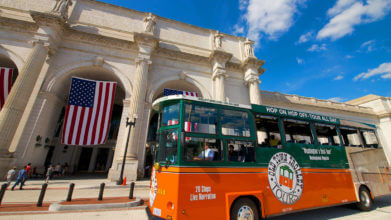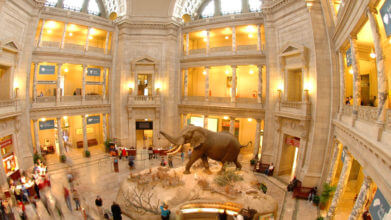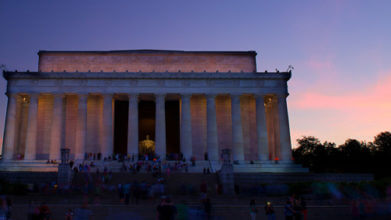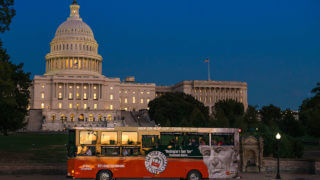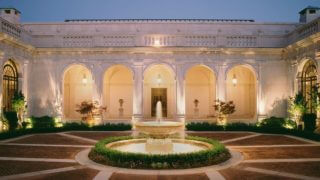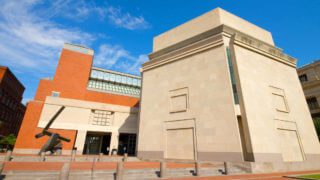Martin Luther King Junior Memorial
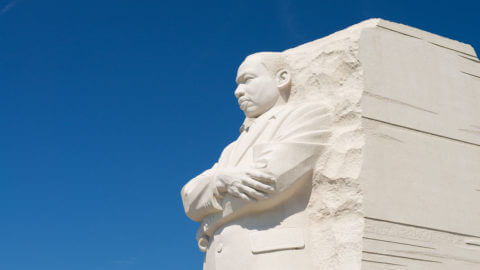
Martin Luther King Jr. Memorial
The Martin Luther King Jr. Memorial, located in Washington, DC’s West Potomac Park, is a powerful tribute to one of the most influential leaders in American history. Opened in August 2011, this 4-acre memorial is part of the National Park Service and stands as a testament to Dr. King’s work in advancing civil rights, equality, and justice for all. The memorial’s address, 1964 Independence Avenue, is symbolic of the year the Civil Rights Act became law — an essential milestone in the fight for racial equality.
At the heart of the memorial is the Stone of Hope, a striking 30-foot-tall sculpture of Dr. King. Visitors reach this monumental piece by passing through two large granite structures known as the Mountains of Despair. These symbolic elements are drawn from Dr. King’s famous “I Have a Dream” speech, where he declared, “Out of the mountain of despair, a stone of hope.” Surrounding the memorial is the Inscription Wall, featuring excerpts from 14 of Dr. King’s most memorable sermons, speeches, and writings. Visitors from around the world come here not only to honor Dr. King but also to reflect on how his words still resonate today.
A Visitor’s Guide to the Martin Luther King Junior Memorial
History of the Martin Luther King Junior Memorial
The Martin Luther King Jr. Memorial was officially opened to the public in August 2011 after years of planning and fundraising. Its creation marked a historic moment, as it became the first memorial on the National Mall dedicated to an African-American person. The effort to establish the memorial began in the 1980s when Alpha Phi Alpha, a historically Black fraternity of which Dr. King was a member, proposed the idea. After decades of advocacy and support, President Bill Clinton signed legislation in 1996 to authorize the memorial’s construction.
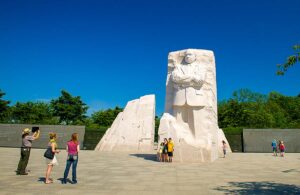
Designed to honor Dr. King’s legacy, the memorial was built at a cost of $120 million, raised through donations from individuals, organizations and corporations. The decision to place the memorial on 1964 Independence Avenue pays tribute to the Civil Rights Act of 1964, a key legislative victory that Dr. King played a major role in influencing. Today, the memorial stands as a permanent reminder of the ongoing fight for equality.
The Stone of Hope, which forms the focal point of the memorial, was designed by Chinese artist Lei Yixin. His vision was to create a powerful representation of Dr. King’s strength and determination, while the Mountains of Despair symbolize the struggles faced in the fight for justice. Since its unveiling, the memorial has become a site of pilgrimage for those wishing to honor Dr. King’s life and legacy, and it continues to inspire new generations of activists and leaders.
Fun Facts About the Martin Luther King Junior Memorial
Named After a Protestant Reformer
Dr. Martin Luther King Jr. was named after the Protestant reformer Martin Luther, reflecting his father’s admiration for the influential German theologian. This connection to religious reform reflects Dr. King’s own leadership in the social and moral reform movements of the 20th century.
A Young College Student
Dr. King was an exceptionally bright student, entering college at the young age of 15. He attended Morehouse College, an institution with a rich history of fostering civil rights leadership. His early academic achievements were a prelude to the brilliance he would later demonstrate as a leader and speaker.
A Civil Rights Leader Arrested 29 Times
Dr. King’s activism came with many challenges, including being arrested 29 times for alleged acts of civil disobedience and protesting against injustice. His dedication to nonviolent resistance was a cornerstone of his philosophy, and these arrests highlighted his willingness to stand up against oppressive laws.
Survived an Assassination Attempt
Before his tragic death in 1968, Dr. King survived an assassination attempt in 1958 when a woman stabbed him during a book signing. The near-fatal wound almost cost him his life, but King recovered and continued his work for civil rights. His resilience in the face of danger only strengthened his resolve to fight for justice.
The King Family Won a Civil Case Against the Government
After Dr. King’s assassination, his family pursued a civil case against the U.S. government, arguing that government agencies were involved in a conspiracy to assassinate him. The King family won the case, which further cemented the legacy of Dr. King’s enduring influence and his fight for justice. This legal victory underscored the complexity of Dr. King’s life and the challenges his family faced even after his death.
Know Before You Go: Planning Your Visit
When planning your visit to the Martin Luther King Jr. Memorial, it’s essential to consider a few key details that will enhance your experience.
Location and Accessibility
The memorial is located in West Potomac Park on the National Mall, with its official address at 1964 Independence Avenue. The memorial is fully accessible, and there are paved paths and wheelchair-friendly routes for visitors. The spacious design ensures that visitors can easily navigate the site, making it a welcoming destination for everyone.
Transport
Public transportation is recommended for visitors, as parking near the National Mall can be limited. The nearest Metro station is Smithsonian, located on the Blue, Orange, and Silver lines. From there, it’s a scenic walk to the memorial, passing several iconic landmarks along the way. Visitors can also take advantage of bike rentals or tour buses, which offer convenient access to the site.
Best Time To Visit
To avoid crowds, consider visiting early in the morning or late in the afternoon. These quieter times allow for a more peaceful and reflective experience, perfect for appreciating the memorial’s serene beauty. Visiting during off-peak hours also gives you better opportunities for photography, especially as the morning light or late afternoon sun casts beautiful shadows across the Stone of Hope.
Things To See at the Martin Luther King Junior Memorial
Visitors to the Martin Luther King Jr. Memorial are treated to a powerful experience that highlights Dr. King’s contributions to civil rights and his lasting impact on the world.
- The Stone of Hope: The towering 30-foot sculpture of Dr. King is the centerpiece of the memorial. Carved from granite, this powerful statue captures the strength and determination of Dr. King as he gazes toward the horizon, symbolizing his unwavering vision of equality. The scale of the statue is awe-inspiring, and it stands as a reminder of Dr. King’s monumental influence on history.
- Mountains of Despair: These two massive pieces of granite that visitors pass through to reach the Stone of Hope symbolize the struggles and challenges of the Civil Rights Movement. Walking through the Mountains of Despair provides a symbolic journey into the heart of Dr. King’s message of hope and perseverance. The design invites visitors to reflect on the difficult path toward justice.
- The Inscription Wall: Surrounding the memorial is the Inscription Wall, which features 14 quotes from Dr. King’s most famous speeches, sermons, and writings. The inscriptions focus on themes of justice, peace, and the power of nonviolent resistance, offering visitors an opportunity to reflect on his powerful words. Each quote has been carefully chosen to capture the essence of Dr. King’s philosophy.
- Quiet Reflection Areas: The memorial includes several quiet areas designed for contemplation and remembrance. These spots provide a peaceful setting for visitors to reflect on Dr. King’s life and the continued fight for equality. The tranquility of the space allows for moments of introspection, making it a unique place to honor Dr. King’s legacy.
- Photography Opportunities: The striking design of the Stone of Hope and the natural beauty of the surrounding landscaping make the memorial a perfect spot for photography. Visitors can capture powerful images of the sculpture, the Tidal Basin, and nearby landmarks. The memorial’s open layout also provides unique angles for photographers looking to document their experience.
Nearby Things To Do
After visiting the Martin Luther King Jr. Memorial, you’ll find yourself in the heart of the National Mall, surrounded by other notable sites. Here are some attractions to add to your itinerary:
National Mall
The National Mall stretches from the Lincoln Memorial to the Capitol Building and is home to many iconic landmarks. Spend time exploring the area, and take in the history and significance of this national treasure. The Mall is perfect for a leisurely stroll while taking in America’s most important monuments and memorials.
Vietnam Veterans Memorial
This moving memorial honors the servicemen and women who fought in the Vietnam War. The black granite walls are etched with the names of over 58,000 soldiers who gave their lives during the conflict. It’s a solemn site that encourages visitors to remember the sacrifices made during the war.
Korean War Veterans Memorial
Another significant site on the National Mall, this memorial honors those who served in the Korean War. Its lifelike statues of soldiers trekking through rugged terrain are a powerful reminder of the sacrifices made. The reflective pool and surrounding trees create a peaceful atmosphere for quiet reflection.
Franklin Delano Roosevelt Memorial
Just a short walk from the Martin Luther King Jr. Memorial, this expansive memorial honors the 32nd president of the United States. It’s divided into four sections, representing each of Roosevelt’s terms in office, and includes waterfalls, sculptures and quotes from his speeches. The FDR Memorial offers a tranquil setting for visitors to reflect on Roosevelt’s leadership during some of America’s most challenging times.
FAQs
Are there any other sculptures or artwork at the Martin Luther King Jr. Memorial?
The Martin Luther King Jr. Memorial focuses primarily on the Stone of Hope sculpture of Dr. King. However, the nearby Inscription Wall, featuring quotes from his writings and speeches, serves as an integral part of the memorial’s design and message.
What architectural style is the Martin Luther King Jr. Memorial?
The memorial is designed with elements of modernism and minimalism, using granite as the primary material to convey strength and permanence. The combination of symbolic design and natural landscaping creates a serene environment that reflects Dr. King’s enduring legacy.
How much time should I plan to spend at the Martin Luther King Jr. Memorial?
You should plan to spend about 30 minutes to an hour exploring the Martin Luther King Jr. Memorial. This allows time to walk through the Mountains of Despair, read the inscriptions on the wall and reflect at the Stone of Hope. If you’re visiting nearby memorials, you may want to allow more time to take in the entire experience of the National Mall.

